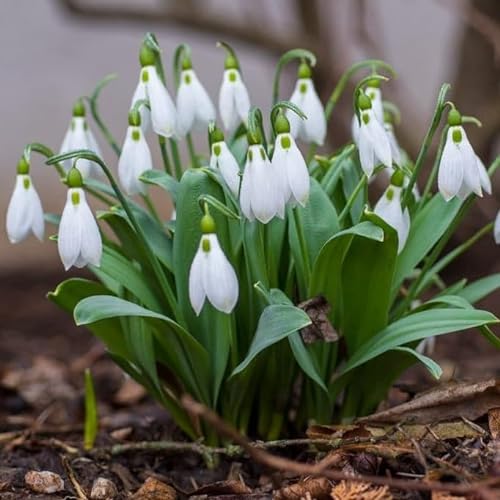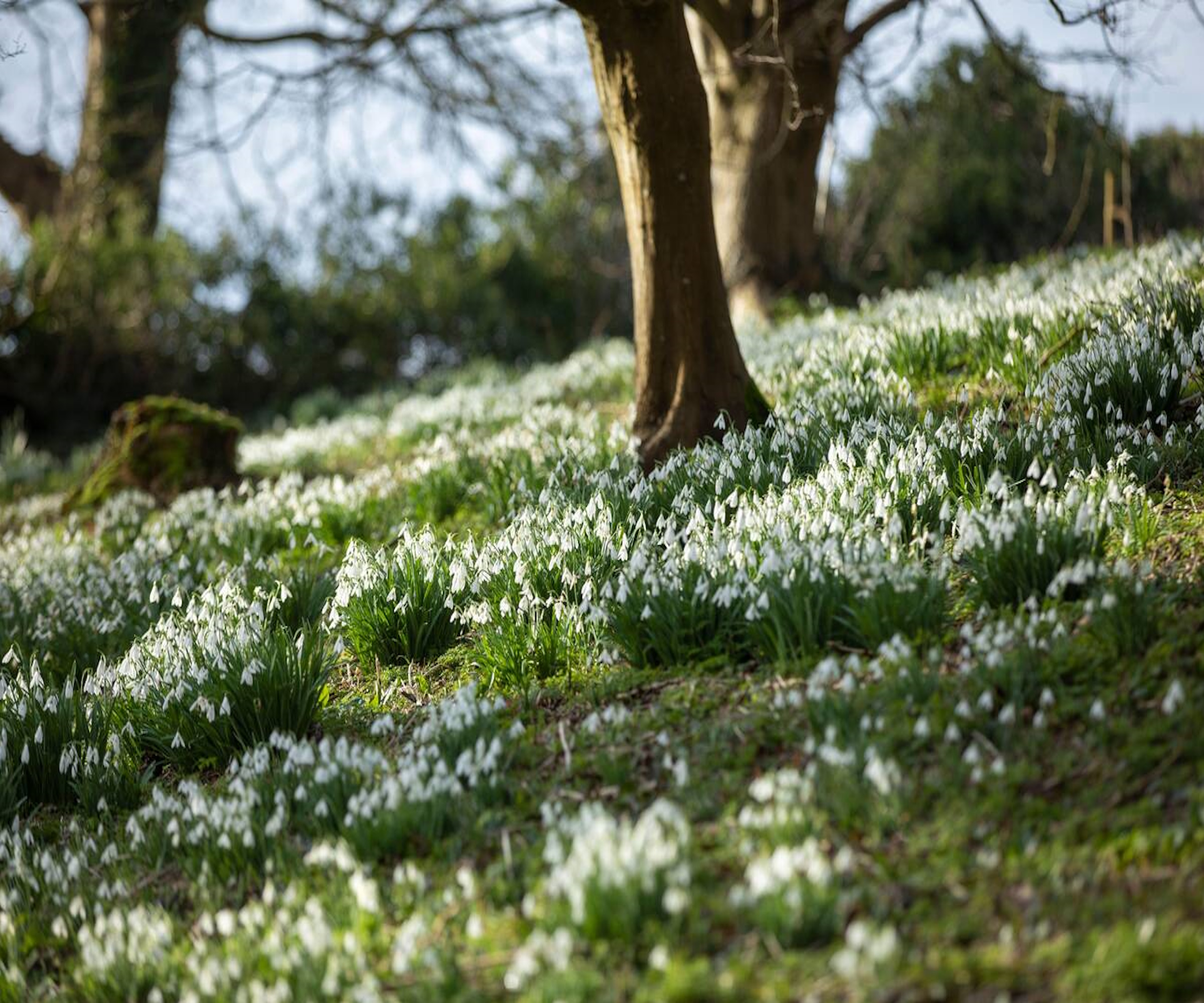It's not too late to plant these delicate winter-flowering bulbs, but you need to get them in the ground now
There is still time to plant snowdrop bulbs, according to a pro gardener


Timing is everything when growing snowdrops. Planting bulbs too late in the year, as winter begins to take hold, will result in failed flowering and disappointment, so getting them in the ground promptly is important. As a former professional gardener, I have grown snowdrops in several private gardens across the UK, and know that planting them at the right time is crucial.
Generally speaking, fall is the time to plant bulbs, and whether you intend to grow snowdrops, tulips or daffodils, it is a good idea to get planting in October and November, as the temperature drops but before the ground is overly wet or frozen. So you still have a couple of weeks to get some in the ground.
Here, I discuss the ideal time to plant snowdrop bulbs in your yard for the best chances of success, helping you fill your borders and pots with striking white blooms during the coldest time of the year.

When to plant snowdrop bulbs
When considering planting snowdrops, remember that these are tough, snow-resilient flowers. While they might look delicate, snowdrops can be grown from US hardiness zone 3 and above, tolerating frozen winters and often blooming when the ground is frozen.
When is the ideal time to plant snowdrop bulbs

Typically blooming between January and March, snowdrops are a sign that spring will soon be on its way. Planting these miniature bulbs requires careful timing to get the best results, and the ideal planting window usually falls somewhere between August and November. It is still perfectly fine to plant as late as November, but in my experience, the sooner the better.
Planting them by November will ensure that your bulbs have enough time to shoot and establish roots before the ground freezes, making them better prepared to produce healthy foliage and flowers in the New Year.
When planting, remember that these are bulbs for shade or part-shade, and it is also important to choose a spot that has well-draining soil. Avoid planting bulbs in waterlogged or overly damp soil, as they can rot if sitting in saturated soil for too long.
In terms of how deep to plant bulbs, bury your snowdrops at least two to three inches deep. Position your bulb with the pointed end facing upwards. Snowdrops look best when planted in natural drifts, so consider placing 10 or 15 bulbs in clumps, one to two feet apart in your borders.

Galanthus ikariae are small snowdrops, often reaching no more than six inches in height. White flowers typically blooms from January to March.
What if I miss the snowdrop bulb planting window?

If you miss this window, I would not advise planting snowdrops in December. Planting bulbs too late in the winter is a common bulb planting mistake to avoid and might end in disappointment when no snowdrops appear. Instead, consider planting snowdrops 'in the green'.
You can buy bulbs already shooting in a garden center, which might make a nice addition to a pot display. Be careful when planting them, however, as snowdrop bulbs do not respond well when being moved at this time of year.
Alternatively, you can wait until after the flowering window and plant snowdrops 'in the green', typically doing so in February, March or April. Planting 'in the green' involves transplanting live plants with foliage intact. You want to do this before the weather warms up, ideally well before May. Also remember that the longer your bulbs are out of the ground, the lower the chances of survival, so planting them as soon as possible is always preferable.
Much the same as planting bulbs in the fall, dig individual holes at a depth of two to three inches, positioning each clump at the same depth as it would have been before it was lifted - you do not want the green stems buried too deeply. You will often be able to identify where the surface level was by a clear color change on the stem.
Once planted, water lightly to settle the soil and give your new snowdrops a boost. Keep an eye on them as they might dry out as the weather warms up. While you won't get any flowers from these frost-hardy plants this year, planting 'in the green' in spring will produce excellent results and robust growth the following winter.
FAQs
Do snowdrops naturalize when planted in borders?
Yes, snowdrops will naturalize and spread across your garden. After a few years in one position, it is a good idea to lift and divide congested clumps, encouraging them to colonize different areas of the yard. This is best done after flowering in March or April.
What unusual variety of snowdrop would you recommend?
There are 20 species of snowdrops that, all native to Europe and Asia. The most popular is the common snowdrop, Galanthus nivalis, but there are many other options available, with more than 2,500 cultivars bred over the centuries. Galanthus ‘Blonde Inge’ was always one of my favorites, with a yellow-green coloration adorning the white hanging petals.
While there are many bulb planting trends that come and go each year, snowdrops are a garden stalwart that, to me, are a timeless addition to any space. Try planting them alongside cyclamen and croci, for pops of color early in the year alongside these dainty, white flowers.
Sign up to the Homes & Gardens newsletter
Design expertise in your inbox – from inspiring decorating ideas and beautiful celebrity homes to practical gardening advice and shopping round-ups.

Thomas is a Content Editor within the Gardens Team at Homes and Gardens. He has worked as a professional gardener for both public spaces and private estates, specializing in productive gardening, growing food and flowers. Trained in Horticulture at the Garden Museum, he has written on gardening and garden history for various publications, including The English Garden, Gardens Illustrated, Hortus, The London Gardener and Bloom. He has co-authored a Lonely Planet travel book, The Tree Atlas, due out in 2024.
-
 Bathroom colors going out of style in 2025 – and the designer-approved shades to decorate with instead
Bathroom colors going out of style in 2025 – and the designer-approved shades to decorate with insteadThese are the colors to swerve in your bathroom decor if you want to create a stylish and design-led space, according to experts
By Emily Moorman
-
 I swear by the ‘ETC’ method to prevent clutter and save money – my expert-backed checklist is transformative
I swear by the ‘ETC’ method to prevent clutter and save money – my expert-backed checklist is transformativeNow I Edit The Cart and save time, money, and energy
By Chiana Dickson
-
 How to weed a garden quickly – professional gardeners reveal the five-minute weeding jobs to do now and get your yard summer-ready
How to weed a garden quickly – professional gardeners reveal the five-minute weeding jobs to do now and get your yard summer-readyShort on time? These time-efficient tasks will keep on top of problem plants
By Thomas Rutter
-
 Can you revive woody rosemary plants? Expert pruning advice from a professional gardener to save old, leggy herbs
Can you revive woody rosemary plants? Expert pruning advice from a professional gardener to save old, leggy herbsWith the right pruning approach, old and woody rosemary plants can be brought back to life
By Thomas Rutter
-
 Your hydrangeas will flourish with bigger blooms and healthier growth thanks to this 1 natural material that is easy to use
Your hydrangeas will flourish with bigger blooms and healthier growth thanks to this 1 natural material that is easy to useDiscover why you should be using leaf mold to mulch hydrangeas
By Drew Swainston
-
 Small yard but want to grow your own crops? This wooden cold frame is 40% off at Wayfair – and it's perfect for tiny patios and apartments
Small yard but want to grow your own crops? This wooden cold frame is 40% off at Wayfair – and it's perfect for tiny patios and apartmentsCold frames are a sensible investment for any gardeners struggling for space on balconies, backyards or patios
By Thomas Rutter
-
 5 fast-growing tiny flowers – expert recommendations to fill your pots and borders with color in record time
5 fast-growing tiny flowers – expert recommendations to fill your pots and borders with color in record timeThese fast-growing tiny flowers prove that miniature can also be marvelous
By Thomas Rutter
-
 How to grow sassafras – for a low-maintenance native tree that can even be planted in shady yards
How to grow sassafras – for a low-maintenance native tree that can even be planted in shady yardsFor an easy-to-grow North American tree, you will not find much better than sassafras
By Thomas Rutter
-
 How to grow crepe myrtle in pots – and transform even the smallest of yards with dazzling flowers this summer
How to grow crepe myrtle in pots – and transform even the smallest of yards with dazzling flowers this summerGrowing crepe myrtles in pots will inject splashes of brilliant color into your outside space
By Thomas Rutter
-
 Best types of delphiniums – 14 stunning varieties for vibrant flower spikes in your yard
Best types of delphiniums – 14 stunning varieties for vibrant flower spikes in your yardPlants Here are our top types of delphiniums for brightening summer borders
By Holly Crossley


